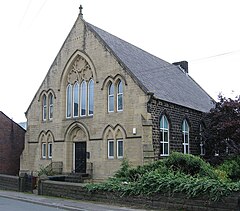Thurlstone
Appearance
| Thurlstone | |
|---|---|
 Thurlstone - Wesleyan Church | |
| OS grid reference | SE232034 |
| Metropolitan borough | |
| Metropolitan county | |
| Region | |
| Country | England |
| Sovereign state | United Kingdom |
| Post town | SHEFFIELD |
| Postcode district | S36 |
| Dialling code | 01226 |
| Police | South Yorkshire |
| Fire | South Yorkshire |
| Ambulance | Yorkshire |
| UK Parliament | |
Thurlstone is a village near Penistone in the metropolitan borough of Barnsley in South Yorkshire, England.[1] Originally it was a small farming community. Some industries developed using water power from the River Don such as corn milling, wire drawing and various wool and cloth processes.[2] Most of these are now gone and only James Durrans (carbon products) and Service Direct owned by 'Don Eddie' remain. The village is now a dormitory for the urban areas of South and West Yorkshire.
Its name is believed to be of Anglo-Saxon origin, possibly referring to the god Thunor. Other sources argue that its name is taken from thirled (pierced) rock which is found at its location.[3] The nearby village Thurgoland may have a similar derivation.
Notable people
- Nicholas Saunderson - A prominent member of the scientific community in the 18th century was born in the village.[4]
Images
-
Looking over to Royd Moor Wind Farm from Thurstone.
-
Work Bank Lane in Thurlstone during the 2 February 2009 Snow in the UK.
References
- ^ Wolffe, John, ed. (2005). Yorkshire Returns of the 1851 Census of Religious Worship: West Riding (South). Borthwick Publications. pp. 96–97. ISBN 1-904497-11-X.
- ^ Hey, David (2015). "20". A History of the South Yorkshire Countryside. Pen & Swords Books Limited. ISBN 978-1-47383-435-4.
- ^ Report and Transactions: Volume 10. Devonshire Association for the Advancement of Science, Literature and Art. 1878. p. 298.
- ^ Fuller, Thomas; Nuttall, P. Austin (1840). The history of the worthies of England: Volume 3. Thomas Tegg. p. 472.
External links
Wikimedia Commons has media related to Thurlstone.


